Module 6: Odds and Ends
A Simple Exercise
In-Class Exercise 6.1:
Download this template
and solve the following problem. Suppose you are given a 2D array
of integers and that each position in the array has the value 0 or 1.
(Thus, a binary matrix). A sub-array of the matrix is considered
a "chessboard" if the following properties hold:
(1) the number of rows equals the number of columns (i.e. it is
square);
(2) there are at least two rows;
(3) the 0's and 1's alternate as in a chessboard (i.e., none of the
neighboring positions of a 0 has a 0).
Your goal is to find the largest sub-matrix that is a chessboard.
Analyse the complexity of your algorithm when the array size
is N x N.
Start by writing pseudocode.
Profiling
Most programming languages include supporting tools such as: (Java example)
- Debuggers (jdb).
- IDE's: Integrated Development Environments (Forte).
- Documentation tools (javadoc).
- Profilers (runhprof).
A profiler
- Inserts "hooks" into your code to enable periodic sampling.
- Builds an execution profile of your code:
=> how much time was spent in each method.
A Java profiling example:
- Consider the following sample program:
- We are given an array of numbers, randomly generated.
- Partial sum: sum of the first k numbers.
- Partial maximum: max of the first k numbers.
- Objective: what is the average partial sum (max) for a
randomly chosen index?
- Here is some sample code:
(source file)
public class ProfileTest {
static int numTrials; // The number of trials to use in averaging.
static int size; // Data (array) size.
static int[] data; // The data.
// Find partial maximum: the max value in data[0],...,data[limit].
static int findMax (int limit)
{
int max = data[0];
for (int i=1; i < limit; i++)
if (data[i] > max)
max = data[i];
return max;
}
// Find partial sum: the sume of data[0],...,data[limit].
static double findSum (int limit)
{
double sum = 0;
for (int i=0; i < limit; i++)
sum += data[i];
return sum;
}
static void estimateMax()
{
// 1. Maintain total.
double total = 0;
// 2. Repeat numTrials times.
for (int n=0; n < numTrials; n++) {
// 2.1 Pick a sub-array randomly.
int limit = (int) UniformRandom.uniform (0, size-1);
// 2.2 Compute partial max.
int value = findMax (limit);
// 2.3 Accumulate.
total += value;
}
// 3. Compute average.
double avg = (double) total / (double) numTrials;
// 4. Output.
System.out.println ("Estimate of maximum=" + avg);
}
static void estimateSum()
{
// 1. Maintain total.
double total = 0;
// 2. Repeat numTrials times.
for (int n=0; n < numTrials; n++) {
// 2.1 Pick a sub-array randomly.
int limit = (int) UniformRandom.uniform (0, size-1);
// 2.2 Compute partial sum.
double value = findSum (limit);
// 2.3 Accumulate.
total += value;
}
// 3. Compute average.
double avg = (double) total / (double) numTrials;
// 4. Output.
System.out.println ("Estimate of sum=" + avg);
}
static void createData ()
{
// Draw the data randomly between 0 and "size":
data = new int [size];
for (int i=0; i < size; i++)
data[i] = (int) UniformRandom.uniform (1, size);
}
public static void main (String[] argv)
{
try {
// Command-line arguments contain the array size and number of trials.
if ( (argv == null) || (argv.length != 2) ) {
System.out.println ("Usage: java ProfileTest ");
System.exit(1);
}
// Obtain the size of the data.
size = Integer.parseInt (argv[0].trim());
// Obtain the number of trials used in averaging.
numTrials = Integer.parseInt (argv[1].trim());
// Create random data.
createData ();
// Estimate the average partial-maximum.
estimateMax ();
// Estimate the average partial-sum.
estimateSum ();
}
catch (Exception e) {
e.printStackTrace();
}
}
}
- Let's run a profile on this code:
- Profiling in Java is supported in the Java Virtual Machine
(JVM).
- To use it, you compile a program normally but execute with
"profiling on".
- Example:
java -Xrunhprof:cpu=samples,file=log.txt,depth=10 ProfileTest 1000 100000
- For details on the options, type
java -Xrunhprof:help
- The output file log.txt contains a sample of how
much time was spent in various methods, e.g.,
CPU SAMPLES BEGIN (total = 37)
rank self accum count trace method
1 32.43% 32.43% 12 15 ProfileTest.findSum
2 18.92% 51.35% 7 13 ProfileTest.findMax
3 5.41% 56.76% 2 19 java.lang.StrictMath.floor
4 5.41% 62.16% 2 3 java.util.jar.Manifest.parseName
5 5.41% 67.57% 2 18 UniformRandom.uniform
6 2.70% 70.27% 1 8 java.util.HashMap.put
7 2.70% 72.97% 1 7 java.lang.String.< init >
8 2.70% 75.68% 1 2 java.lang.Character.toLowerCase
9 2.70% 78.38% 1 9 java.util.jar.JarFile.getManifest
10 2.70% 81.08% 1 10 java.util.jar.Attributes.read
11 2.70% 83.78% 1 6 java.lang.Object.clone
12 2.70% 86.49% 1 4 java.util.jar.Attributes.< init >
13 2.70% 89.19% 1 1 java.util.jar.Manifest.parseName
14 2.70% 91.89% 1 14 java.lang.FloatingDecimal.dtoa
15 2.70% 94.59% 1 5 java.util.jar.Attributes.< init >
16 2.70% 97.30% 1 16 UniformRandom.uniform
17 2.70% 100.00% 1 17 java.lang.Math.floor
CPU SAMPLES END
Thus, the most time was spent in findSum, according to
this estimate.
- More about Java's profiling:
- The JVM provides an API for "profiling applications" to use
in monitoring a program.
- runhprof is one such application.
- Currently (as of 2001), both the JVMPI and runhprof
are not yet stable.
- Next, let's improve the code for only the maximum's:
- We'll leave the partial-sum computation as is, for comparison.
- Note: partial maxima can be computed once.
- Here's part of the code:
(source file)
public class ProfileTest2 {
// ...
// findMax now returns the stored value.
static int findMax (int limit)
{
return max[limit];
}
// ...
static void estimateMax()
{
// 1. First find partial maximums.
max = new int [data.length];
for (int k=0; k < max.length; k++) {
max[0] = data[0];
int m = data[0];
// 1.1 Find the partial maximum for each value of k.
for (int i=1; i<=k; i++)
if (data[i] > m)
m = data[i];
// 1.2 Store as k-th partial maximum.
max[k] = m;
}
// 2. Now estimate.
double total = 0;
// 3. Repeat numTrials times.
for (int n=0; n < numTrials; n++) {
// 3.1 Pick a sub-array randomly.
int limit = (int) UniformRandom.uniform (0, size-1);
// 3.2 Compute partial max.
int value = findMax (limit);
// 3.3 Accumulate.
total += value;
}
// 4. Compute average.
double avg = (double) total / (double) numTrials;
// 5. Output.
System.out.println ("Estimate of maximum=" + avg);
}
// ...
}
- This results in much less time computing the maxima (compared
to sums):
CPU SAMPLES BEGIN (total = 28)
rank self accum count trace method
1 32.14% 32.14% 9 18 ProfileTest2.findSum
2 7.14% 39.29% 2 12 ProfileTest2.estimateMax
3 7.14% 46.43% 2 15 UniformRandom.uniform
4 3.57% 50.00% 1 3 java.lang.Object.clone
5 3.57% 53.57% 1 16 UniformRandom.uniform
6 3.57% 57.14% 1 20 UniformRandom.uniform
7 3.57% 60.71% 1 14 java.lang.StrictMath.floor
8 3.57% 64.29% 1 7 java.lang.StringBuffer.append
9 3.57% 67.86% 1 1 java.util.jar.Manifest.parseName
10 3.57% 71.43% 1 13 UniformRandom.uniform
11 3.57% 75.00% 1 19 UniformRandom.uniform
13 3.57% 82.14% 1 2 java.util.jar.Manifest.read
14 3.57% 85.71% 1 4 java.util.jar.Attributes.read
15 3.57% 89.29% 1 6 java.util.Properties.load
16 3.57% 92.86% 1 8 sun.net.www.protocol.file.Handler.openConnection
17 3.57% 96.43% 1 10 java.net.URL.equals
18 3.57% 100.00% 1 17 java.lang.StrictMath.floor
CPU SAMPLES END
- Another improvement:
A C profiling example:
- We'll look at the same computation in C
(source file)
double *data; // The data.
int N; // Size of the data.
int numTrials; // Number of trials to use in estimation.
// Random-number generator
static r_seed = 12345678L;
double uniform ()
{
static long m = 2147483647;
static long a = 48271;
static long q = 44488;
static long r = 3399;
long t, lo, hi;
hi = r_seed / q;
lo = r_seed - q * hi;
t = a * lo - r * hi;
if (t > 0)
r_seed = t;
else
r_seed = t + m;
return ( (double) r_seed / (double) m );
}
// Build random array
double* makeRandomArray (int length)
{
int i;
double *A = (double*) malloc (sizeof(double) * length);
for (i=0; i < length; i++) {
A[i] = floor (length*uniform ());
}
return A;
}
// Find partial maximum: the max value in data[0],...,data[limit].
int findMax (int limit)
{
int i;
double sum;
int max;
max = data[0];
for (i=1; i < limit; i++)
if (data[i] > max)
max = data[i];
return max;
}
// Find partial sum: the sum of data[0],...,data[limit].
double findSum (int limit)
{
int k;
double sum;
sum = 0;
for (k=0; k < limit; k++)
sum += data[k];
return sum;
}
void estimateMax ()
{
double total, avg;
int n, value, limit;
// 1. Maintain total.
total = 0;
// 2. Repeat numTrials times.
for (n=0; n < numTrials; n++) {
// 2.1 Pick a sub-array randomly.
limit = floor (N*uniform());
// 2.2 Compute partial max.
value = findMax (limit);
// 2.3 Accumulate.
total += value;
}
// 3. Compute average.
avg = total / (double) numTrials;
// 4. Output.
printf ("Estimate of maximum=%lf\n", avg);
}
void estimateSum ()
{
double total, avg;
int n, value, limit;
// 1. Maintain total.
total = 0;
// 2. Repeat numTrials times.
for (n=0; n < numTrials; n++) {
// 2.1 Pick a sub-array randomly.
limit = floor (N*uniform());
// 2.2 Compute partial sum.
value = findSum (limit);
// 2.3 Accumulate.
total += value;
}
// 3. Compute average.
avg = total / (double) numTrials;
// 4. Output.
printf ("Estimate of sum=%lf\n", avg);
}
int main ()
{
// Set data size and number of trials.
N = 1000;
numTrials = 100000;
// Create random data.
data = makeRandomArray (N);
// Estimate the average partial-maximum.
estimateMax();
// Estimate the average partial-sum.
estimateSum();
}
- We'll profile it using GNU's C tools: gcc and
gprof:
- Compile with the "profile" option:
gcc -pg profiletest.c -oprofiletest -lm
- Then, execute: (this creates gmon.out, profiling data).
profiletest
- Finally, produce readable profiling data:
gprof
- For example:
% cumulative self self total
time seconds seconds calls ms/call ms/call name
48.1 3.15 3.15 100000 0.03 0.03 findMax [4]
45.0 6.10 2.95 100000 0.03 0.03 findSum [6]
3.1 6.30 0.20 internal_mcount [7]
1.4 6.39 0.09 603012 0.00 0.00 .umul [9]
1.1 6.46 0.07 201000 0.00 0.00 .div [10]
0.6 6.50 0.04 1 40.00 3284.53 estimateMax [3]
0.3 6.52 0.02 201000 0.00 0.00 __floor [11]
0.3 6.54 0.02 1 20.00 3064.53 estimateSum [5]
0.2 6.55 0.01 201000 0.00 0.00 uniform [8]
0.0 6.55 0.00 32 0.00 0.00 _return_zero [299]
0.0 6.55 0.00 16 0.00 0.00 _mutex_lock [300]
0.0 6.55 0.00 16 0.00 0.00 mutex_unlock [21]
...
- The same improvements as shown for the Java version make
sense here:
How profiling works:
- Most profiling is designed to be non-intrusive.
- Run a separate thread to sample the stack:
=> stack contains method-call status.
- Repeated samples enable estimating the number of method calls
for each method.
- Some profiling tools are instrusive.
=> insert actual breaks in code.
Beyond Profiling
Limitations of profiling:
- Method history may be too coarse a granularity.
- You may already know which method is likely to have the bottleneck.
- Difficult to evaluate large multi-threaded, multi-machine applications.
- Need long running times for sampling to work correctly.
- Most significant limitation: does not suggest "what" but "where".
Timing sections of code:
- In Java:
long startTime = System.currentTimeMillis();
// ... algorithm runs here ...
double timeTaken = System.currentTimeMillis() - startTime;
- In C:
#include <sys/times.h>
// NOTE: times.h may lie in different directories in some systems.
// This example compiles on standard Linux distributions.
static struct tms t_record;
static double timer_start_time, timer_end_time;
void start_timer ()
{
times (&t_record);
timer_start_time = (double) (t_record.tms_utime + t_record.tms_stime);
}
double stop_timer ()
{
times (&t_record);
timer_end_time = (double) (t_record.tms_utime + t_record.tms_stime);
return (timer_end_time - timer_start_time);
}
double timer_difference ()
{
return (timer_end_time - timer_start_time);
}
int main ()
{
double elapsed_time;
// Start timing.
start_timer();
// ... compute ...
// Get time taken.
elapsed_time = stop_timer();
}
System performance:
- Generally, evaluating system performance is difficult.
- Example:
- A 3-tier system with front-end, middleware and back-end database.
- Database may run on a multiprocessor.
- Front-end and middleware may use different machines.
- Where are the bottlenecks?
- Modeling tools:
- Develop analytic model of performance.
- Solve model and try to predict worst-case performance.
- Simulation:
- Write (typically, discrete-event) simulation of system,
leaving out unnecessary detail.
- Run simulations under various application scenarios and data sets.
- Identify bottlenecks.
Stepwise Refinement in Problem Solving
Stepwise refinement not only applies to coding, but also to problem-solving.
We'll use an example to illustrate: the maximal rectangle problem
- Given: a 2D binary array (2D array of 0's and 1's).
- Goal: find the largest sub-array (rectangle) consisting
entirely of 1's.
First attempt: the obvious algorithm
- Scan through array, stopping at each element.
- Treat each element as a potential topleft corner of the rectangle.
- For each such topleft corner, try all other elements as a
potential bottom-right corner.
The code:
public class NaiveMaxRect implements MaxRectangleAlgorithm {
// ...
// See if the subrectangle (i,j,a,b) is filled with 1's.
boolean checkFilled (int i, int j, int a, int b)
{
for (int k1=i; k1 <= a; k1++) {
for (int k2=j; k2 <= b; k2++) {
if (A[k1][k2] == 0) {
// Quit as soon as a zero is detected.
return false;
}
}
}
return true;
}
// Compute the area of rectangle (i,j,a,b)
int computeArea (int i, int j, int a, int b)
{
// Bad input:
if (a < i)
return -1;
if (b < j)
return -1;
// Area.
return (a-i+1) * (b-j+1);
}
// The algorithm.
public int findMaxRectangleArea (int[][] A)
{
// ...
// 1. Initialize.
int maxArea = 0;
// 2. Outer double-for-loop to consider all possible positions
// for topleft corner.
for (int i=0; i < M; i++) {
for (int j=0; j < N; j++) {
// 2.1 With (i,j) as topleft, consider all possible bottom-right corners.
for (int a=i; a < M; a++) {
for (int b=j; b < N; b++) {
// 2.1.2 See if rectangle(i,j,a,b) is filled.
boolean filled = checkFilled (i, j, a, b);
// 2.1.3 If so, compute it's area.
if (filled) {
// Check area.
int area = computeArea (i, j, a, b);
// If the area is largest, adjust maximum and update coordinates.
if (area > maxArea) {
maxArea = area;
topLeftX = i; topLeftY = j;
botRightX = a; botRightY = b;
}
}
}
} // end-3rd-for
} // end-2nd-for
} // end-outermost-for
return maxArea;
}
// ...
}
Some improvements:
- Check area first before scanning for 1's!
=> if area is too small, ignore rectangle.
- Eliminate as many size-1 rectangles from search as possible.
- Check corners for 0's before proceeding.
The code:
// ...
public int findMaxRectangleArea (int[][] A)
{
// ...
// 1. Check if array is all zeroes: this is O(mn) work.
boolean found = false;
outer:
for (int i=0; i < M; i++) {
for (int j=0; j < N; j++) {
if (A[i][j] == 1) {
found = true;
topLeftX = botRightX = i;
topLeftY = botRightY = j;
break outer;
}
}
}
// 2. If all zeroes, no further checks are required.
if (! found)
return 0;
// 3. We know there's at least one 1 x 1 rectangle (of area 1).
int maxArea = 1;
// 4. Outer double-for-loop to consider all possible positions
// for topleft corner.
for (int i=0; i < M; i++) {
for (int j=0; j < N; j++) {
// 4.1 With (i,j) as topleft, consider all possible bottom-right corners.
for (int a=i; a < M; a++) {
for (int b=j; b < N; b++) {
// 4.1.1 No need to check size-1 rectangles.
if ( (a == i) && (b == j) )
continue;
// 4.2.1 If a corner is zero, no need to check further.
if ( (A[i][j] == 0) || (A[a][b] == 0) )
continue;
// 4.2.2 First compute area to see if we should scan for 1's.
int area = computeArea (i, j, a, b);
if (area > maxArea) {
// 4.2.2.1 Only if area is larger should we bother checking.
boolean filled = checkFilled (i, j, a, b);
if (filled) {
maxArea = area;
topLeftX = i; topLeftY = j;
botRightX = a; botRightY = b;
}
} // endif-area
} // end-innermost-for
} // end-3rd-for
} // end-2nd-for
} // end-outermost-for
return maxArea;
}
// ...
Analysis (for both variations):
- Suppose the array is m x n.
- Each topleft corner visits about O(mn) locations.
- For each such topleft corner, the bottom right corner visits
no more than O(mn) positions.
- An evaluation (checking for 1's) takes O(mn) in the
worst-case for each rectangle checked.
- Total: O(m3 n3)
(worst-case).
Let's see if we can avoid some unnecessary comparisons:
- Consider this example:
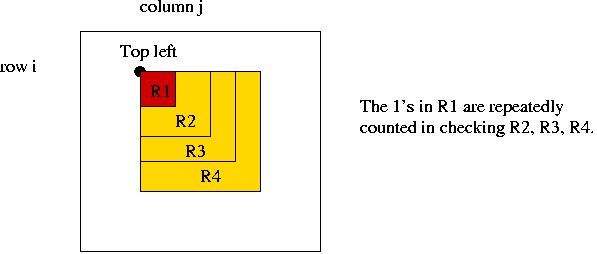
=> Small rectangles enclosed by larger ones are always scanned
when processing the larger ones.
- Use bottom up approach:
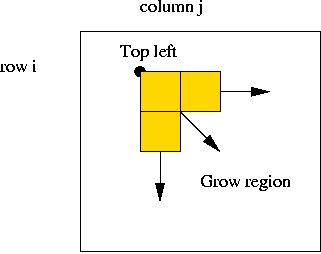
- Start at topleft corner (i, j).
- Grow region rightwards and downwards as much as possible.
- A key observation:
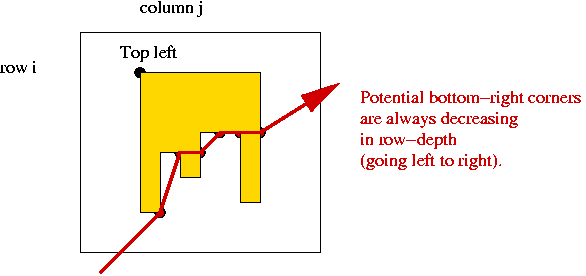
- Consider potential bottom-right corners.
- These form an ascending sequence right to left.
=> never need look "deeper" than in previous column.
- Code:
// ...
// Start with top left at i,j and find largest rectangle of 1's.
// Use java.awt.Point to store and return two integers.
Point growRegion (int i, int j)
{
// 1. best_a and best_b will record the best bottom-right corner so far.
int best_a = i, best_b = j;
// 2. a and b will range over possible locations for the bottom-right corner.
int a = i, b = j;
// 3. There is no need to search below rowMax, which is updated
// as we proceed.
int rowMax = M-1;
// 4. Scan left to right along row i using index b as long as there are 1's.
while ( (b <= N-1) && (A[i][b]) != 0) {
// 4.1 Start at the highest possible row, row i.
a = i;
// 4.2 Descend into current column (column b) as far down as possible.
while ( (a <= rowMax) && (A[a][b] == 1) )
a = a + 1;
// 4.3 Back up to the last "1".
a = a - 1;
// 4.4 Update rowMax if we stopped at an earlier row.
if (a < rowMax)
rowMax = a;
// 4.5 Check to see if found a larger rectangle.
int area = computeArea (i, j, a, b);
// 4.6 If the rectangle is larger, update.
if (area > maxArea) {
best_a = a;
best_b = b;
maxArea = area;
topLeftX = i; topLeftY = j;
botRightX = best_a; botRightY = best_b;
}
// 4.7 Continue with next column.
b++;
} // endwhile
// 5. Return best bottom-right corner.
return new Point (best_a, best_b);
}
public int findMaxRectangleArea (int[][] A)
{
// ...
// 1. Check if array is all zeroes.
// ...
// 2. If all zeroes, no further checks are required.
// 3. We know there's at least one 1 x 1 rectangle (of area 1).
maxArea = 1;
// 4. Outer double-for-loop to consider all possible positions
// for topleft corner.
for (int i=0; i < M-1; i++) {
for (int j=0; j < N-1; j++) {
// 4.1 Find the largest possible rectangle with topleft at i,j.
Point p = growRegion (i, j);
// NOTE: growRegion itself updates the current largest rectangle,
// so there's no need to do it here.
}
} // end-outermost-for
// 5. Return value.
return maxArea;
}
// ...
- Have we reduced the complexity?
- Potential topleft corners: O(mn).
- Each execution of growRegion is O(mn), worst-case.
=> O(m2 n2) overall.
An improvement:
- As the top-left moves along a row, some columns are repeatedly scanned:
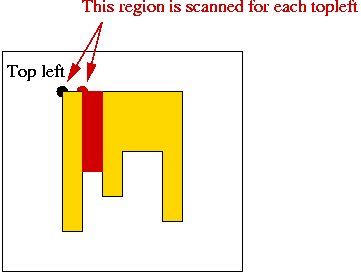
- Idea:
- We only need the number of 1's.
=> use a cache.
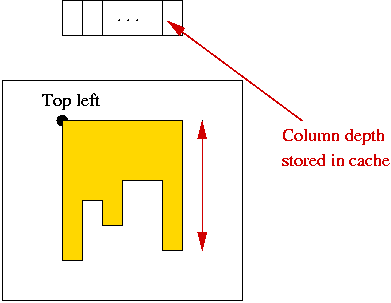
- Pre-compute cache for each row before moving topleft-corner
along row.
- Code:
// ...
// Start with top left at i,j and find largest rectangle of 1's.
Point growRegion (int i, int j)
{
// 1. best_a and best_b will record the best bottom-right corner so far.
int best_a = i, best_b = j;
// 2. a and b will range over possible locations for the bottom-right corner.
int a = i, b = j;
// 3. There is no need to search below rowMax, which is updated
// as we proceed.
int rowMax = M-1;
// 4. Scan left to right along row i using index b as long as there are 1's.
while ( (b <= N-1) && (A[i][b]) != 0) {
// Replace this:
// a = i;
// while ( (a <= rowMax) && (A[a][b] == 1) )
// a = a + 1;
// a = a - 1;
// with:
// 4.1 Descend into current column (column b) as far down as possible - in time O(1)!
a = i + cache[b] - 1;
// 4.2 Update rowMax if we stopped at an earlier row.
if (a < rowMax)
rowMax = a;
else
a = rowMax;
// 4.3 Check to see if found a larger rectangle.
int area = computeArea (i, j, a, b);
// 4.4 If the rectangle is larger, update.
if (area > maxArea) {
// ...
}
// 4.5 Continue with next column.
b++;
} // endwhile
// 5. Return best bottom-right corner.
return new Point (best_a, best_b);
}
// For each row, create the cache that's used repeatedly in the row.
void fillCache (int i)
{
// 1. Initialize, since cache is created just once.
Arrays.fill (cache, 0);
// 2. Walk across the columns.
for (int j=0; j < N; j++) {
// 2.1 For each column position (i.e., potential top-left corner),
// find the longest column of 1's.
for (int a=i; a < M; a++) {
if (A[a][j] == 0)
break;
else
cache[j] ++;
}
} // end-column-scan.
}
public int findMaxRectangleArea (int[][] A)
{
// ...
// Create space for cache - use maximum possible size.
cache = new int [N];
// ...
for (int i=0; i < M-1; i++) {
// Fill cache for row i.
fillCache (i);
// Scan columns in row.
for (int j=0; j < N-1; j++) {
// Find the largest possible rectangle with topleft at i,j.
Point p = growRegion (i, j);
}
} // end-outermost-for
// ...
}
// ...
- Improvement in complexity:
- We have reduced growRegion to O(n) (number of columns).
- Overall: O(m n2).
- However, we require O(n) additional space.
Note: the material on the maximal rectangle problem is based on an
article by D.Vanderwoode in Dr.Dobbs Journal, 1998. Much of the code
is completely re-written here (in Java).




